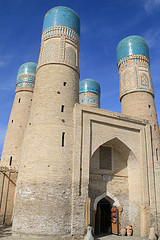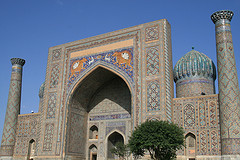A tale of two cities: Bukhara and Samarkand
Within five minutes of our arrival in Bukhara, we were drinking vodka with the jovial, large-bellied owner of our guesthouse – straight, and in a bowl, as is the custom here. Even in the most Muslim and least Russian of the three Central Asian Republics we have visited so far, this most famous Russian export is alive and well.
After being pleasantly surprised with how much we liked Khiva, we were a little disappointed with Bukhara. The monuments themselves were, as always in Uzbekistan, magnificent, but chronic over-restoration on many of them, combined with a touristy atmosphere, brought down our opinion, and somehow despite the extraordinary sights on offer, Bukhara the city in the end was not the sum of those parts. Unlike Khiva, the monuments are spread out within the city, and the areas between them are modern and/or given over to tourist bazaars (which, given our no-souvenir policy while we remain homeless, are of no interest to us). So yes, Bukhara is a real city, and people really live there, but there’s nothing really interesting about the city in itself aside from the monuments. I had expected an old city full of interesting alleys, with a Central Asian feel in the style of Kashgar, but it was nothing like that at all. Don’t get me wrong – it’s still a pretty amazing place, but our high expectations were not quite met.
 Among Bukhara’s monuments, for the most part we found the smaller, less imposing ones to be the most interesting, including the four-domed Char Minar, and the city’s oldest mosque and mausoleum. These tend to be unrestored and free of large French tour groups, resulting in an ambience not often felt on the Uzbek tourist circuit. Of the more major sights, the soaring Kalon Minaret is extremely impressive, so much so that it was spared by Genghis Khan, who destroyed everything else in his path between Mongolia and Europe. For a fantastic view of the minaret and surrounding monuments, we climbed to the rooftop of a nearby medressa, for which of course we not only paid, but had to bargain the price – as you do for everything in Uzbekistan, including entrance fees to sights, service charges at restaurants and currency exchange rates.
Among Bukhara’s monuments, for the most part we found the smaller, less imposing ones to be the most interesting, including the four-domed Char Minar, and the city’s oldest mosque and mausoleum. These tend to be unrestored and free of large French tour groups, resulting in an ambience not often felt on the Uzbek tourist circuit. Of the more major sights, the soaring Kalon Minaret is extremely impressive, so much so that it was spared by Genghis Khan, who destroyed everything else in his path between Mongolia and Europe. For a fantastic view of the minaret and surrounding monuments, we climbed to the rooftop of a nearby medressa, for which of course we not only paid, but had to bargain the price – as you do for everything in Uzbekistan, including entrance fees to sights, service charges at restaurants and currency exchange rates.
Samarkand, the greatest and most famous of Silk Road cities and Uzbek tourist sites, was our next stop. It was already a magnificent city when Alexander marched by in the fourth century B.C., and though it was razed to the ground by Genghis Khan, it was subsequently rebuilt on an even grander scale by Timur the Lame (so called because he walked with a limp; he was in fact a conqueror of the highest order, and his 14th century Timurid empire, with Samarkand as its showpiece capital, stretched from Kashgar to the Mediterranean).
 Even more so than Bukhara, Samarkand is a modern city, with wide boulevards and cultivated gardens, and as such not at all what I had expected. But where it trumps Bukhara is that it somehow feels much less touristy and, most importantly, the Timurid monuments are staggering in their size and ambition. The Registan, consisting of three grand edifices facing a central courtyard, must be one of the top 20, or perhaps even one of the top 10, historic places in the world, despite its over-restoration; one of our travelling companions said he found it more impressive than the Taj Mahal. If the corrupt uniformed police guards weren’t trying to extort money from you every two minutes, it would have been even better.
Even more so than Bukhara, Samarkand is a modern city, with wide boulevards and cultivated gardens, and as such not at all what I had expected. But where it trumps Bukhara is that it somehow feels much less touristy and, most importantly, the Timurid monuments are staggering in their size and ambition. The Registan, consisting of three grand edifices facing a central courtyard, must be one of the top 20, or perhaps even one of the top 10, historic places in the world, despite its over-restoration; one of our travelling companions said he found it more impressive than the Taj Mahal. If the corrupt uniformed police guards weren’t trying to extort money from you every two minutes, it would have been even better.
Aside from the Registan, Samarkand has many other significant monuments, including the Avenue of Mausoleums, and the tomb of Timur himself, a simple but beautiful dark jade tomb. As the story goes, a Soviet archaeologist opened up the tomb on June 21, 1941, and not only confirmed that the body was indeed ‘lame’ in the right leg, but found an inscription saying: ‘whoever opens this will be defeated by an enemy more fearsome than I.’ Of course, at about 4am the following morning, the largest army in history – 4 million soldiers – crossed the Soviet border as part of Operation Barbarossa, Hitler’s invasion of the Soviet Union. (Though, since the USSR ultimately defeated Nazi Germany despite 25-30 million lives lost, the anecdote doesn’t hold up that well in the full light of history.)
Since we stayed a day less in Bukhara than we had originally planned, we managed to arrive in Tashkent last night ahead of our 2:35am flight tonight. So, after an entire year backpacking across all corners of Asia – 3.5 months on the subcontinent, 3 months in Southeast Asia, 3 months in China, and 2.5 months in Central Asia – it’s now at an end, and we think we’ve earned ourselves a ‘holiday’ in Europe. We fly to Riga tonight and will spend two weeks in the three Baltic states (Latvia, Estonia & Lithuania), where we’ve never been, before heading to Rome for our annual visit.
Tags: Asia, Bukhara, Central Asia, Samarkand, Timur, Travel, Uzbekistan

Great article! Thanks!